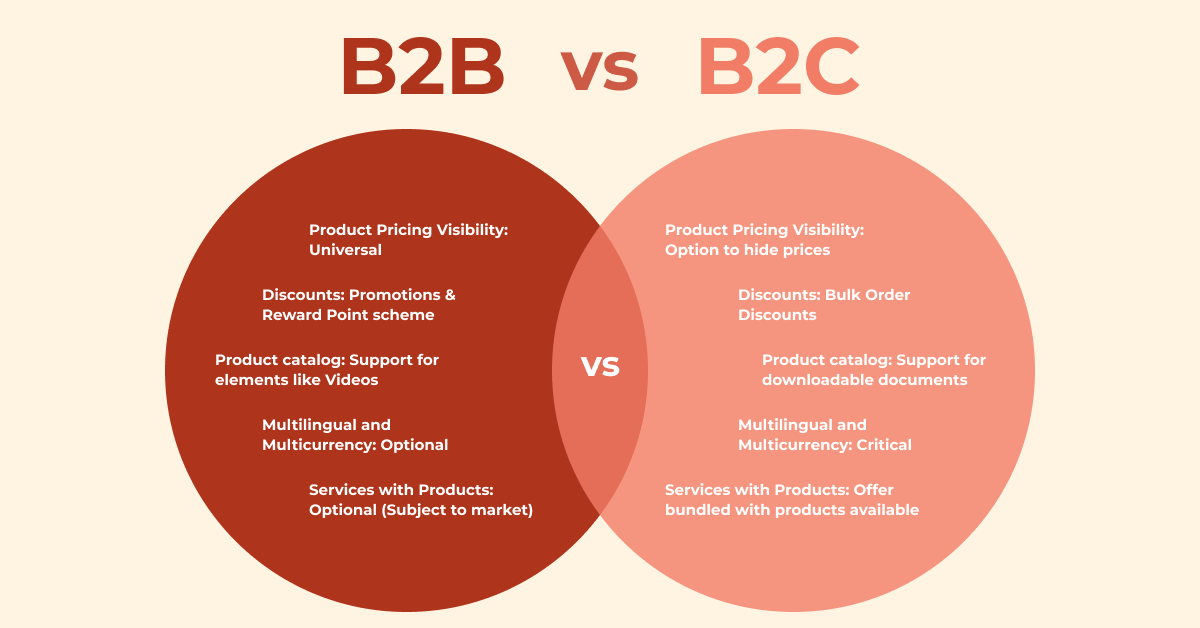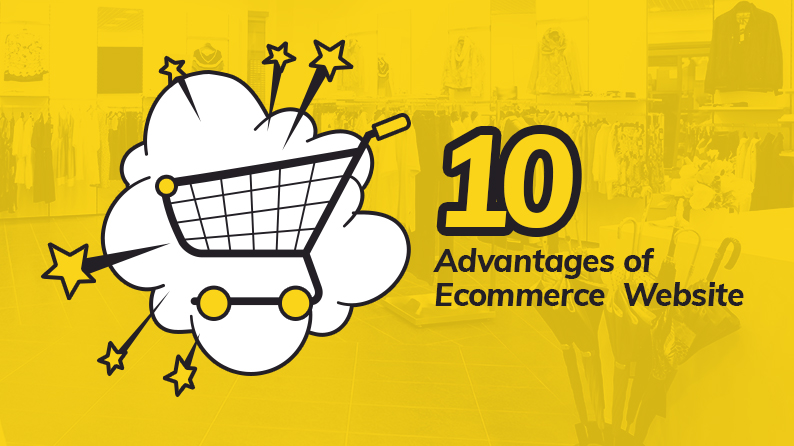If you were to ask buyers, the end consumers, what made them commit to a purchase? The response could be beyond just the value addition of the product to their life. Things like: I like to buy from this brand; or This makes me feel good, Oh, My friend has it too! will start to take center stage, at times more than the product itself.
But if you post the same question to a business, the priorities will shift to ROI, brand image, long-term business prospects, traction with consumers, product value for the consumers and more.
There is a considerable difference in how buying triggers work for end consumers and businesses. Likewise, the whole purchase journey differs for both sets of buyers. While sellers in the physical world have a broader range of variables to address this difference, including human interactions. The digital space interacts via the device itself. Here, the controllable variables are the platform features and UI/UX. These variables team up to offer buyers the shopping experience they are looking for.
Since expectations and the buying journey of buyers, in the case of B2B or B2C business interactions vary, these variables need to vary as well. In this blog, let’s explore the difference between B2B and B2C eCommerce platforms – that allow buyers and sellers in both domains to interact and transact in a purpose-driven ecosystem, tailored to their needs.
B2B and B2C: What is the Difference?
As humans, all our actions stem from perceived desires. According to eminent American psychologist Abraham Maslow, human needs can be classified into self-actualization, esteem, belongingness, safety, and physiology. Indeed, in the case of B2C, these are the key drivers behind our purchase decisions as consumers.
On the contrary, for B2B, the drivers are business goals’ driven. This difference in priorities between buyers in each case leads to distinct processes. Discussed below are the differences between these processes that eCommerce platforms need to consider.
Buyers’ Profile
While it is easier to define the buyer in B2C interactions, B2B is complex and business interactions can be between two businesses anywhere across the value chain of a product. For instance, consider a scenario where a product reseller (like retailers), interacts with wholesalers, or in the case wherein a business procures a product for internal consumption. While both are B2B interactions, they will have different variables at play. This is also one of the reasons why B2B eCommerce platforms have to be more dynamic than B2C – and they have to incorporate varying requirements.
Sales
Since the priorities of buyers in both domains differ, their approach to sales varies significantly as well. Take the example of a fashion accessory like a luxury watch. Consumers will consider buying it for themselves or as a gift. For the buyer, this might be the only luxury watch they buy from the seller. However, businesses that buy the same product to be sold to the end buyer – may need to offer the product for a longer period, till it has sustainable buyer traction.
In most B2C instances, consumers will be the only decision-makers in the purchase. The product and the brand will matter more than the sellers. And in most scenarios, the consumer journey will be short. In B2C, businesses also have the opportunity to understand impulse sales psychology and leverage their platform to trigger such buying behavior.
On the other hand, the sales cycle in B2B is longer. Here, business relations can play a key role in the sales process, especially if the buyers are considering reselling the procured products. In B2B, the decision makers can be more than one, and the sales cycle tends to be longer.
Transactions (Value and Terms)
Let’s consider the same example of the luxury watch. Consumers are unlikely to buy the product beyond a few numbers. Businesses, however, need to go for a higher number.
Transactions in B2C are low volume and lesser value. On the contrary, B2B transactions are higher in volume. Also, B2B transactions are cyclic, which means a manufacturer or a distributor may accept orders beyond their real-time inventory stocks.
Moreover, consider the case where a business procures custom-built machinery or a bespoke software solution. In such scenarios, the business deal can include long-term commitments, from the buyers and sellers. So the transaction terms need to be more flexible and may involve dynamic payment options.
Product Pricing Strategy
For vendors selling to consumers, the prices of the products are subject to the business strategy of the business and not the consumers themselves. Barring exceptions like auctions, prices of the products can be universally visible to all. Any discounts or marketing promotions applicable can also be displayed alongside.
But business deals between businesses themselves work differently. They can be subject to order volume, payment terms, the location of the buyers, aspirations for market penetration, inventory stocks, and/or other complexities that come with B2B. Hence vendors in the domain would want more flexibility to implement their pricing strategy.
Build a platform giving your B2B vendors complete flexibility
Marketing and Research
Another outcome of the varying priorities of buyers in both domains is how sellers reach out to their target audience. In B2C, the marketing is more experience-driven, aligned with the aspirations of the consumers. While in B2B, the buyers need more information and value-driven details. They want to evaluate the product from a business sense perspective. Hence, buyers in both domains have a varying approach to research.
Services and Products
While this difference is more subject to the niche of the business. Still, B2C deals are focused on either services or products. Vendors have the capability to operate exclusively in either of the two scenarios, as end consumers may not want both under one roof.
However, in B2B – the services gain more significance. These services may be related to the product itself. For instance, a business may consider procuring T-shirts from one vendor and T-shirt printing services from another. Another example can be a business procuring products that need regular maintenance from authorized personnel. They will need such services from a single source.
Difference in B2B and B2C eCommerce Platforms
The differences between buyers in B2C and B2B emphasize a key imperative ― there can’t be a one-size-fits-all solution. Especially in an age where eCommerce has matured (and is further evolving) to give buyers tailored personalized experiences – buyers in both domains need an ecosystem that is suited to their priorities.
So the question now worth pondering over is – How do you address these varying priorities with your eCommerce platform?
The answer lies in understanding these differences and offering an exclusive ecosystem that suits the needs of the specific user type. Let’s have a look at the difference in features of a B2C and a B2B eCommerce platform.
| Variation Addressed | Parameter | B2C Platform |
B2B Platform |
| Pricing Strategy/Sales |
Product Pricing | Fixed | Flexible based on quantity/or Request For Quote |
| Product Pricing Visibility | Universal | Option to hide prices | |
| Sales/Transactions | Discounts | Promotions & Reward Point scheme | Bulk Order Discounts |
| Payment Terms | Fixed with eWallets and Cash On Delivery option | Flexible with Part Payment option (Credit Line) |
|
| Minimum Order Quantity | Optional | Required | |
| Custom Invoicing | Not Required | Required | |
| Marketing & Research |
UI/UX | Engaging, Marketing oriented | Clean UI, detail & information-driven |
| Product catalog | Support for elements like Videos | Support for downloadable documents | |
| Product reviews | Parameters based | Information based | |
| Search | Elastic with keyword search | Advanced with keyword search | |
| Shop/Product Tags | Required | Not Required | |
| Operations (Difference in Buyers profiles) |
Shipping | Low cost options are pivotal, in-house, etc. | Low cost options are critical, vendors’ in-house, etc. |
| Returns | Critical | Subject to market | |
| Multilingual and Multicurrency | Optional | Critical | |
| Services with Products |
– | Optional (Subject to market) | Offer bundled with products/exclusive/available at checkout |
If you’ve analyzed here keenly we have discussed some platform features/modules in this blog. The reason for this is despite their differences, the underlying principles in both B2C and B2B remain the same. eCommerce as a whole has some fundamental underpinnings that are common to users of both domains.
Engage your users with pivotal and proven features
Wrapping Up – Use Tailored Readymade Solutions for B2C/B2B eCommerce
A key to winning in eCommerce is reaching out to the target audience with what they need. If you can solve key pain points of the users, you have their attention. In a multi-vendor eCommerce marketplace, these users are both sellers and buyers. Your business will be giving them a platform to conveniently carry out their activities. Moreover, with eCommerce reaching the level of maturity that it has, your users already have certain minimum requirements, when it comes to expectations.
Hence, it is essential that you consider offering the right set of features, tailored to each user type. By the information in this blog, you can get an understanding of how your eCommerce platform can meet their specific needs.
To make your entrepreneurial journey even more convenient, you can use readymade solutions, that are purpose-built to meet the needs of each user type. Both YoKart and YoKart B2B, are solutions built for each of these specific needs. While YoKart caters to the needs of users in the B2C domain, YoKart B2B provides an apt platform for B2B users. For instance, YoKart B2B offers features like RFQ, bulk order discounts, MOQ, part payments, custom invoicing, and support for services & products, right out of the box. Likewise, YoKart is a solution tailor-made for an intuitive and memorable shopping experience for consumers of today.
Both solutions come with a host of pre-integrations and are offered with one-time payment options. The best way to understand the working is to go through the demos of both YoKart and YoKart B2B.



